Towards Animal-Free Toxicology: Establishment of Two Larval Brown Trout Cell Lines for Environmental Risk Assessment
Abstract
1. Introduction
2. Materials and Methods
2.1. Ethic Statement
2.2. Cell Isolation, Cell Culture, and Cryopreservation
2.3. Observation of Cell Viability
2.4. Comparative Analysis of Two STRlar Cell Lines
2.5. Ecotoxicological Studies
3. Results
3.1. Observation of Larval Brown Trout Cell Migration
3.2. Cell Culture Handling
3.3. Cell Impedance and Response to Chemical Solvents
3.4. Ecotoxicological Response of STRlar1 Cell Line
3.5. Ecotoxicological Response of STRlar2 Cell Line
4. Discussion
4.1. Comparison of Growth Behaviour
4.2. Reaction to Chemical Exposure
5. Conclusions
Author Contributions
Funding
Institutional Review Board Statement
Data Availability Statement
Acknowledgments
Conflicts of Interest
Abbreviations
| 3R | Replacement, Reduction and Refinement |
| DMSO | Dimethyl sulfoxide |
| ECHA | European Chemicals Agency |
| EDTA | Ethylenediaminetetraacetic acid |
| EPA | US Environmental Protection Agency |
| FBS | Foetal Bovine Serum |
| IUCN | International Union for Conservation of Nature and Natural Resources |
| L-15 | Leibovitz-15 |
| OECD | Organisation for Economic Co-operation and Development |
| P/S | Penicillin/streptomycin |
| PBS | Dulbecco’s Phosphate-Buffered Saline |
| REACH | Registration, Evaluation, Authorization and Restriction of Chemicals |
| TierSchG | Tierschutzgesetz |
| TPP | Techno Plastic Products AG |
References
- Kim, S.H.; Lee, S.I.; Lee, S.H.; Jo, S.E.; Kim, K.Y. The Molecular Monitoring of an Invasive Freshwater Fish, Brown Trout (Salmo trutta), Using Real-Time PCR Assay and Environmental Water Samples. Animals 2025, 15, 659. [Google Scholar] [CrossRef]
- McGlade, C.L.O.; Dickey, J.W.E.; Kennedy, R.; Donnelly, S.; Nelson, C.-A.; Dick, J.T.A.; Arnott, G. Behavioural traits of rainbow trout and brown trout may help explain their differing invasion success and impacts. Sci. Rep. 2022, 12, 1757. [Google Scholar] [CrossRef]
- Townsend, C.R. Invasion biology and ecological impacts of brown trout Salmo trutta in New Zealand. Biol. Conserv. 1996, 78, 13–22. [Google Scholar] [CrossRef]
- Lowe, S.; Browne, M.; Boudjelas, S.; De Poorter, M. 100 of the World’s Worst Invasive Alien Species A selection from the Global Invasive Species Database; ISSG Office: Newmarket, Auckland, 2000; p. 12. [Google Scholar]
- FishBase. Available online: https://www.fishbase.org (accessed on 3 June 2025).
- Darwall, W.R.T.; Salmo trutta. The IUCN Red List of Threatened Species 2023. Available online: https://www.iucnredlist.org/species/19861/58301467 (accessed on 3 June 2025).
- Borgwardt, F.; Unfer, G.; Auer, S.; Waldner, K.; El-Matbouli, M.; Bechter, T. Direct and Indirect Climate Change Impacts on Brown Trout in Central Europe: How Thermal Regimes Reinforce Physiological Stress and Support the Emergence of Diseases. Front. Environ. Sci. 2020, 8, 59. [Google Scholar] [CrossRef]
- Franco, M.E.; Hollender, J.; Schirmer, K. Differential biotransformation ability may alter fish biodiversity in polluted waters. Environ. Int. 2025, 195, 109254. [Google Scholar] [CrossRef]
- Heier, L.S.; Lien, I.B.; Strømseng, A.E.; Ljønes, M.; Rosseland, B.O.; Tollefsen, K.-E.; Salbu, B. Speciation of lead, copper, zinc and antimony in water draining a shooting range—Time dependant metal accumulation and biomarker responses in brown trout (Salmo trutta L.). Sci. Total Environ. 2009, 407, 4047–4055. [Google Scholar] [CrossRef]
- Mariussen, E.; Heier, L.S.; Teien, H.C.; Pettersen, M.N.; Holth, T.F.; Salbu, B.; Rosseland, B.O. Accumulation of lead (Pb) in brown trout (Salmo trutta) from a lake downstream a former shooting range. Ecotoxicol. Environ. Saf. 2017, 135, 327–336. [Google Scholar] [CrossRef] [PubMed]
- Meland, S.; Heier, L.S.; Salbu, B.; Tollefsen, K.E.; Farmen, E.; Rosseland, B.O. Exposure of brown trout (Salmo trutta L.) to tunnel wash water runoff—Chemical characterisation and biological impact. Sci. Total Environ. 2010, 408, 2646–2656. [Google Scholar] [CrossRef]
- Nguyen, T.V.; Kumar, A.; Trang, P.N. The use of fish cell lines as in-vitro ecotoxicological tools: A cellular solution to aquaculture sustainability. Aquaculture 2024, 593, 741302. [Google Scholar] [CrossRef]
- Bols, N.C.; Dayeh, V.R.; Lee, L.E.J.; Schirmer, K. Chapter 2 Use of fish cell lines in the toxicology and ecotoxicology of fish. Piscine cell lines in environmental toxicology. In Biochemistry and Molecular Biology of Fishes; Elsevier: Amsterdam, The Netherlands, 2005; Volume 6, pp. 43–84. [Google Scholar]
- Castaño, A.; Bols, N.; Braunbeck, T.; Dierickx, P.; Halder, M.; Isomaa, B.; Kawahara, K.; Lee, L.E.J.; Mothersill, C.; Pärt, P.; et al. The use of Fish Cells in Ecotoxicology: The Report and Recommendations of ECVAM Workshop 47. Altern. Lab. Anim. 2003, 31, 317–351. [Google Scholar] [CrossRef]
- Fischer, M.; Belanger, S.E.; Berckmans, P.; Bernhard, M.J.; Bláha, L.; Coman Schmid, D.E.; Dyer, S.D.; Haupt, T.; Hermens, J.L.M.; Hultman, M.T.; et al. Repeatability and Reproducibility of the RTgill-W1 Cell Line Assay for Predicting Fish Acute Toxicity. Toxicol. Sci. 2019, 169, 353–364. [Google Scholar] [CrossRef]
- ISO21115; Water Quality—Determination of Acute Toxicity of Water Samples and Chemicals to a Fish Gill Cell Line (RTgill-W1). ISO: Geneva, Switzerland, 2019; p. 38.
- Bols, N.C.; Barlian, A.; Chirino-Trejo, M.; Caldwell, S.J.; Goegan, P.; Lee, L.E.J. Development of a cell line from primary cultures of rainbow trout, Oncorhynchus mykiss (Walbaum), gills. J. Fish Dis. 1994, 17, 601–611. [Google Scholar] [CrossRef]
- Xiong, Y.; Chen, X.; Li, F.; Chen, Z.; Qin, Z. Zebrafish larvae acute toxicity test: A promising alternative to the fish acute toxicity test. Aquat. Toxicol. 2022, 246, 106143. [Google Scholar] [CrossRef] [PubMed]
- Bairoch, A. The Cellosaurus, a Cell-Line Knowledge Resource. J. Biomol. Tech. 2018, 29, 25–38. [Google Scholar] [CrossRef] [PubMed]
- Jakubowska, M.; Białowąs, M.; Stankevičiūtė, M.; Chomiczewska, A.; Jonko-Sobuś, K.; Pažusienė, J.; Hallmann, A.; Bučaitė, A.; Urban-Malinga, B. Effects of different types of primary microplastics on early life stages of rainbow trout (Oncorhynchus mykiss). Sci. Total Environ. 2022, 808, 151909. [Google Scholar] [CrossRef]
- Weeks Santos, S.; Cachot, J.; Cormier, B.; Mazzella, N.; Gourves, P.-Y.; Clérandeau, C.; Morin, B.; Gonzalez, P. Environmentally Relevant Mixture of Pesticides Affect Mobility and DNA Integrity of Early Life Stages of Rainbow Trout (Oncorhynchus mykiss). Toxics 2021, 8, 174. [Google Scholar] [CrossRef]
- Sumpter, J.P.; Margiotta-Casaluci, L. Environmental Occurrence and Predicted Pharmacological Risk to Freshwater Fish of over 200 Neuroactive Pharmaceuticals in Widespread Use. Toxics 2022, 10, 233. [Google Scholar] [CrossRef]
- Yan, L.; Yao, X.; Wang, P.; Zhao, C.; Zhang, B.; Qiu, L. Effect of polypropylene microplastics on virus resistance in spotted sea bass (Lateolabrax maculatus). Environ. Pollut. 2024, 342, 123054. [Google Scholar] [CrossRef]
- Zhi, S.; Wang, J.; Wang, Y.; Yang, L.; Qin, C.; Yan, X.; Zhao, M.; Liu, M.; Qu, L.; Nie, G. Establishment and characterization of Yellow River carp (Cyprinus carpio haematopterus) muscle cell line and its application to fish virology and immunology. Fish Shellfish Immunol. 2023, 139, 108859. [Google Scholar] [CrossRef]
- Goswami, M.; Yashwanth, B.S.; Trudeau, V.; Lakra, W.S. Role and relevance of fish cell lines in advanced in vitro research. Mol. Biol. Rep. 2022, 49, 2393–2411. [Google Scholar] [CrossRef]
- Lee, L.E.; Dayeh, V.R.; Schirmer, K.; Bols, N.C. Applications and potential uses of fish gill cell lines: Examples with RTgill-W1. In Vitr. Cell. Dev. Biol.–Anim. 2009, 45, 127–134. [Google Scholar] [CrossRef]
- Solhaug, A.; Dowd, G.C.; Dayeh, V.R.; Sindre, H.; Lee, L.E.J.; Bols, N.C. Improve your success with fish cell lines—Small things that matter. In Vitr. Cell. Dev. Biol.-Anim. 2025. [Google Scholar] [CrossRef]
- Cellosaurus. Available online: https://www.cellosaurus.org/index.html (accessed on 6 June 2025).
- Banaee, M.; Multisanti, C.R.; Impellitteri, F.; Piccione, G.; Faggio, C. Environmental toxicology of microplastic particles on fish: A review. Comp. Biochem. Physiol. Part C Toxicol. Pharmacol. 2025, 287, 110042. [Google Scholar] [CrossRef]
- Saha, R.; Dutta, S.M. Pesticides’ mode of action on aquatic life. Toxicol. Rep. 2024, 13, 101780. [Google Scholar] [CrossRef] [PubMed]
- Wolf, K.; Quimby, M.C. Established Eurythermic Line of Fish Cells in vitro. Science 1962, 135, 1065–1066. [Google Scholar] [CrossRef]
- Lee, L.E.J.; Clemons, J.H.; Bechtel, D.G.; Caldwell, S.J.; Han, K.-B.; Pasitschniak-Arts, M.; Mosser, D.D.; Bols, N.C. Development and characterization of a rainbow trout liver cell line expressing cytochrome P450-dependent monooxygenase activity. Cell Biol. Toxicol. 1993, 9, 279–294. [Google Scholar] [CrossRef]
- U.S. Environmental Protection Agency. Ecological Effects Test Guidelines OPPTS 850.1400 Fish Early-Life Stage Toxicity Test; EPA 712–C–96–121; U.S. Environmental Protection Agency: Washington DC, USA, 1996.
- Lutze, P.; Brenmoehl, J.; Tesenvitz, S.; Ohde, D.; Wanka, H.; Meyer, Z.; Grunow, B. Effects of Temperature Adaptation on the Metabolism and Physiological Properties of Sturgeon Fish Larvae Cell Line. Cells 2024, 13, 269. [Google Scholar] [CrossRef] [PubMed]
- Schäfer, N.; Kaya, Y.; Rebl, H.; Stüeken, M.; Rebl, A.; Nguinkal, J.A.; Franz, G.P.; Brunner, R.M.; Goldammer, T.; Grunow, B.; et al. Insights into early ontogenesis: Characterization of stress and development key genes of pikeperch (Sander lucioperca) in vivo and in vitro. Fish Physiol. Biochem. 2021, 47, 515–532. [Google Scholar] [CrossRef]
- Odintsova, N.A.; Dyachuk, V.A.; Nezlin, L.P. Muscle and neuronal differentiation in primary cell culture of larval Mytilus trossulus (Mollusca: Bivalvia). Cell Tissue Res. 2010, 339, 625–637. [Google Scholar] [CrossRef] [PubMed]
- Varshney, S.; Lundås, M.; Siriyappagouder, P.; Kristensen, T.; Olsvik, P.A. Ecotoxicological assessment of Cu-rich acid mine drainage of Sulitjelma mine using zebrafish larvae as an animal model. Ecotoxicol. Environ. Saf. 2024, 269, 115796. [Google Scholar] [CrossRef]
- Pratiwi, H.M.; Takagi, T.; Rusni, S.; Inoue, K. Euryhaline fish larvae ingest more microplastic particles in seawater than in freshwater. Sci. Rep. 2023, 13, 3560. [Google Scholar] [CrossRef]
- Henke, A.N.; Chilukuri, S.; Langan, L.M.; Brooks, B.W. Reporting and reproducibility: Proteomics of fish models in environmental toxicology and ecotoxicology. Sci. Total Environ. 2024, 912, 168455. [Google Scholar] [CrossRef]
- Moritz, T.; Bierbach, D.; Schwarzer, J.; Grunow, B. Recommendations for scientific fish husbandry–a series for promoting animal welfare, reproducibility and transferability in ichthyologic research. Bull. Fish Biol. 2024, 20, 35–48. [Google Scholar]
- Grunow, B.; Noglick, S.; Kruse, C.; Gebert, M. Isolation of cells from Atlantic sturgeon Acipenser oxyrinchus oxyrinchus and optimization of culture conditions. Aquat. Biol. 2011, 14, 67–75. [Google Scholar] [CrossRef]
- Kaya, Y.; Tönißen, K.; Verleih, M.; Rebl, H.; Grunow, B. Establishment of an in vitro model from the vulnerable fish species Coregonus maraena (maraena whitefish): Optimization of growth conditions and characterization of the cell line. Cell Biol. Int. 2022, 47, 548–559. [Google Scholar] [CrossRef]
- Grunow, B.; Franz, G.P.; Tönißen, K. In Vitro Fish Models for the Analysis of Ecotoxins and Temperature Increase in the Context of Global Warming. Toxics 2021, 9, 286. [Google Scholar] [CrossRef]
- Victorelli, S.; Passos, J.F. Telomeres and Cell Senescence-Size Matters Not. eBioMedicine 2017, 21, 14–20. [Google Scholar] [CrossRef]
- Zavyalova, E.A.; Carpova, M.A.; Bulina, K.Y.; Alontseva, D.A.; Droshnev, A.E. Receiving new perspective for biotechnology and virology cell cultures of fishes. IOP Conf. Ser. Earth Environ. Sci. 2019, 315, 072006. [Google Scholar] [CrossRef]
- Chadha, Y.; Khurana, A.; Schmoller, K.M. Eukaryotic cell size regulation and its implications for cellular function and dysfunction. Physiol. Rev. 2024, 104, 1679–1717. [Google Scholar] [CrossRef] [PubMed]
- Innocenti, M. New insights into the formation and the function of lamellipodia and ruffles in mesenchymal cell migration. Cell Adh. Migr. 2018, 12, 401–416. [Google Scholar] [CrossRef] [PubMed]
- Gardel, M.L.; Schneider, I.C.; Aratyn-Schaus, Y.; Waterman, C.M. Mechanical integration of actin and adhesion dynamics in cell migration. Annu. Rev. Cell Dev. Biol. 2010, 26, 315–333. [Google Scholar] [CrossRef]
- Schmitz, S. Der Experimentator Zellkultur, 4th ed.; Springer Spektrum: Berlin/Heidelberg, Germany, 2020. [Google Scholar]
- Gstraunthaler, G.; Lindl, T. Zell- und Gewebekultur, Allgemeine Grundlagen und spezielle Anwendungen, 7th ed.; Springer Spektrum: Berlin/Heidelberg, Germany, 2013; Volume XVI.II, pp. 154–157. [Google Scholar]
- Freshney, R.I. Culture of Animal Cells: A Manual of Basic Technique and Specialized Applications, 7th ed.; John Wiley & Sons: Hoboken, NJ, USA, 2015. [Google Scholar]
- ECHA. Dimethyl Sulfoxide. Endpoint Summary. Available online: https://echa.europa.eu/de/registration-dossier/-/registered-dossier/15007/6/2/1 (accessed on 3 June 2025).
- Awan, M.; Iryna, B.; Roland, F.; Barry, F.; Anatoliy, G.; Julie, K.; Mark, L.; Pavel, M.; Alexander, P.; Yuri, P.; et al. Dimethyl Sulfoxide: A Central Player Since the Dawn of Cryobiology, is Efficacy Balanced by Toxicity? Regen. Med. 2020, 15, 1463–1491. [Google Scholar] [CrossRef]
- Cheng, C.-Y.; Song, J.; Pas, J.; Meijer, L.H.H.; Han, S. DMSO Induces Dehydration near Lipid Membrane Surfaces. Biophys. J. 2015, 109, 330–339. [Google Scholar] [CrossRef] [PubMed]
- Majdi, S.; Najafinobar, N.; Dunevall, J.; Lovric, J.; Ewing, A.G. DMSO Chemically Alters Cell Membranes to Slow Exocytosis and Increase the Fraction of Partial Transmitter Released. ChemBioChem 2017, 18, 1898–1902. [Google Scholar] [CrossRef]
- de Ménorval, M.-A.; Mir, L.M.; Fernández, M.L.; Reigada, R. Effects of Dimethyl Sulfoxide in Cholesterol-Containing Lipid Membranes: A Comparative Study of Experiments In Silico and with Cells. PLoS ONE 2012, 7, e41733. [Google Scholar] [CrossRef]
- Rubin, E.; Rottenberg, H. Ethanol-induced injury and adaptation in biological membranes. Fed. Proc. 1982, 41, 2465–2471. [Google Scholar]
- Simon, L.; Souza-Smith, F.M.; Molina, P.E. Alcohol-Associated Tissue Injury: Current Views on Pathophysiological Mechanisms. Annu. Rev. Physiol. 2022, 84, 87–112. [Google Scholar] [CrossRef]
- Brodowski, L.; Schröder-Heurich, B.; Kipke, B.; Schmidt, C.; Von Kaisenberg, C.; Versen-Hoeynck, F. Low Ethanol Concentrations Promote Endothelial Progenitor Cell Capacity and Reparative Function. Cardiovasc. Ther. 2020, 2020, 4018478. [Google Scholar] [CrossRef]
- Neuman, M.G.; Shear, N.H.; Cameron, R.G.; Katz, G.; Tiribelli, C. Ethanol-induced apoptosis in vitro. Clin. Biochem. 1999, 32, 547–555. [Google Scholar] [CrossRef] [PubMed]
- de Silva, A.F.; de Cruz, C.; Garlich, N.; Cerveira Junior, W.R.; Pitelli, R.A. Sensitivity of aquatic organisms to ethanol and its potential use as bioindicators. Acta Scientiarum. Biol. Sci. 2016, 38, 377–385. [Google Scholar] [CrossRef][Green Version]
- Clayman, C.L.; Connaughton, V.P. Neurochemical and Behavioral Consequences of Ethanol and/or Caffeine Exposure: Effects in Zebrafish and Rodents. Curr. Neuropharmacol. 2022, 20, 560–578. [Google Scholar] [CrossRef]
- Massicotte-Nolan, P.; Glofcheski, D.J.; Kruuv, J.; Lepock, J.R. Relationship between Hyperthermic Cell Killing and Protein Denaturation by Alcohols. Radiat. Res. 1981, 87, 284–299. [Google Scholar] [CrossRef] [PubMed]
- Jover, R.; Ponsoda, X.; Castell, J.V.; Gómez-Lechón, M.J. Evaluation of the cytotoxicity of ten chemicals on human cultured hepatocytes: Predictability of human toxicity and comparison with rodent cell culture systems. Toxicol. In Vitr. 1992, 6, 47–52. [Google Scholar] [CrossRef] [PubMed]
- Brandão, J.C.; Bohets, H.H.L.; Van De Vyver, I.E.; Dierickx, P.J. Correlation between the in vitro cytotoxicity to cultured fathead minnow fish cells and fish lethality data for 50 chemicals. Chemosphere 1992, 25, 553–562. [Google Scholar] [CrossRef]
- Gülden, M.; Mörchel, S.; Seibert, H. Comparison of mammalian and fish cell line cytotoxicity: Impact of endpoint and exposure duration. Aquat. Toxicol. 2005, 71, 229–236. [Google Scholar] [CrossRef]
- ICH. ICH Harmonised Guideline, Impurities: Guideline for Residual Solvents Q3C(R9); ICH: Geneva, Switzerland, 2024. [Google Scholar]
- U.S. Environmental Protection Agency. Toxicological review of acetone (CAS No. 67-64-1). In Support of Summary Information on the Integrated Risk Information System (IRIS); U.S. Environmental Protection Agency: Washington, DC, USA, 2003. [Google Scholar]
- Johanson, G. Acetone. In Patty’s Toxicology; John Wiley & Sons, Inc.: Hoboken, NJ, USA, 2023; pp. 1–18. [Google Scholar]
- Pace, D.M.; Elliott, A. Effects of Acetone and Phenol on Established Cell Lines Cultivated in Vitro. Cancer Res. 1962, 22, 107–112. [Google Scholar]
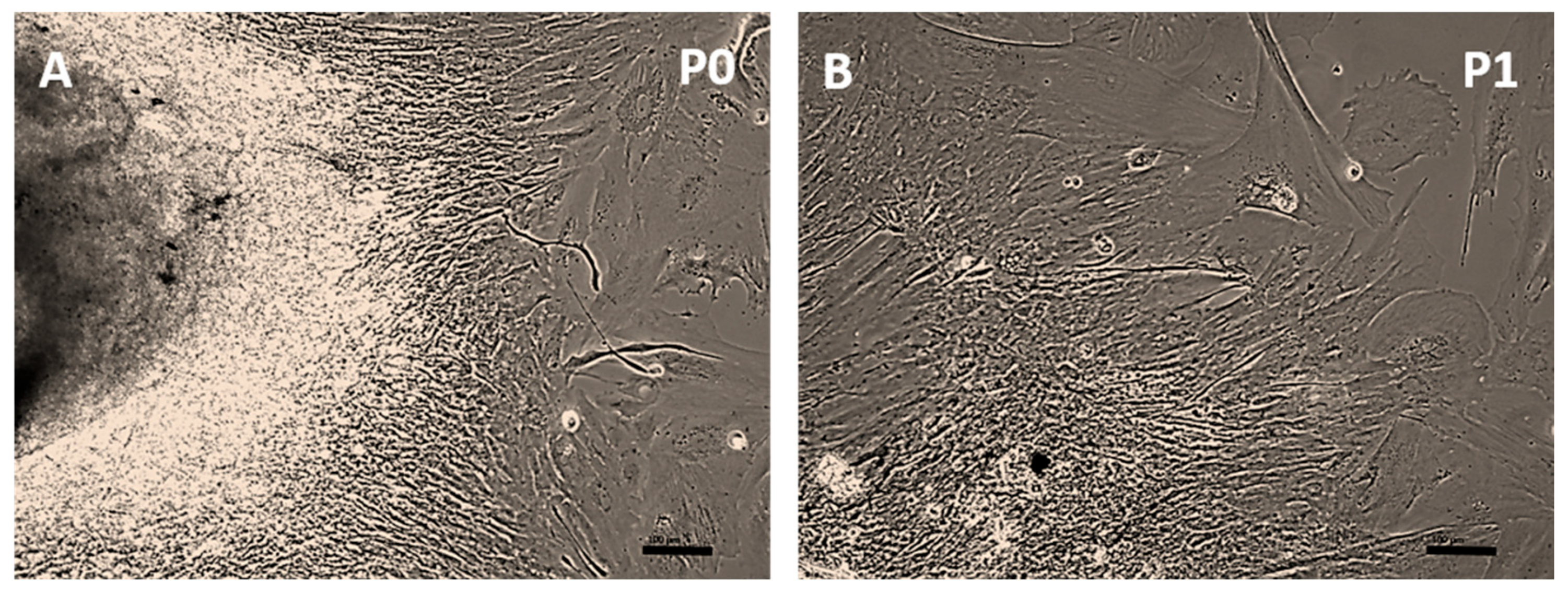
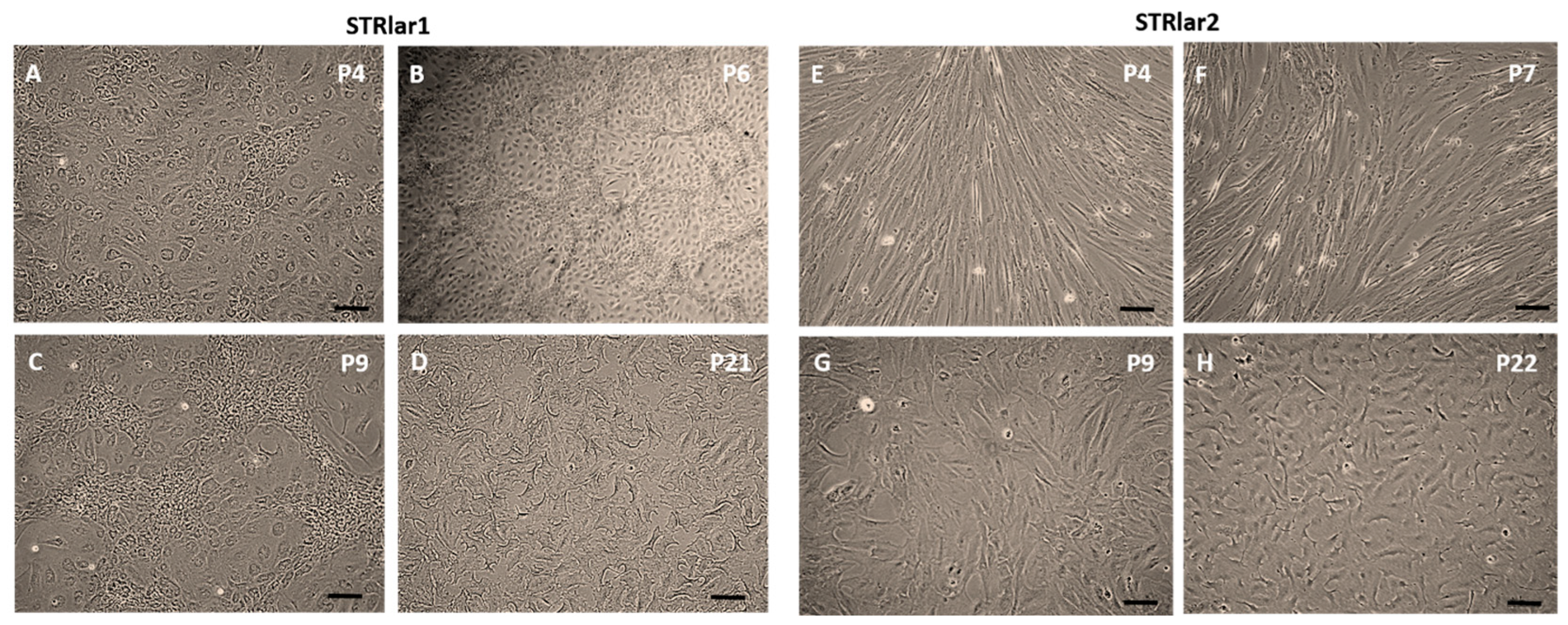
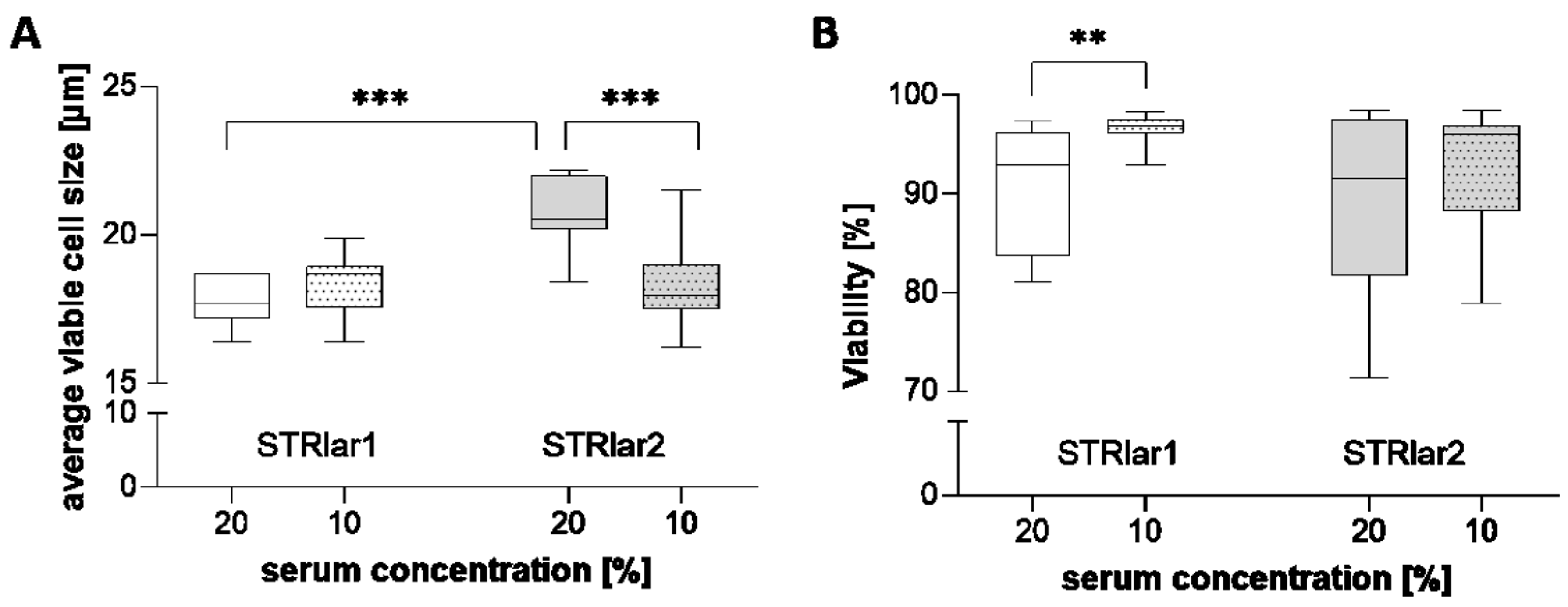
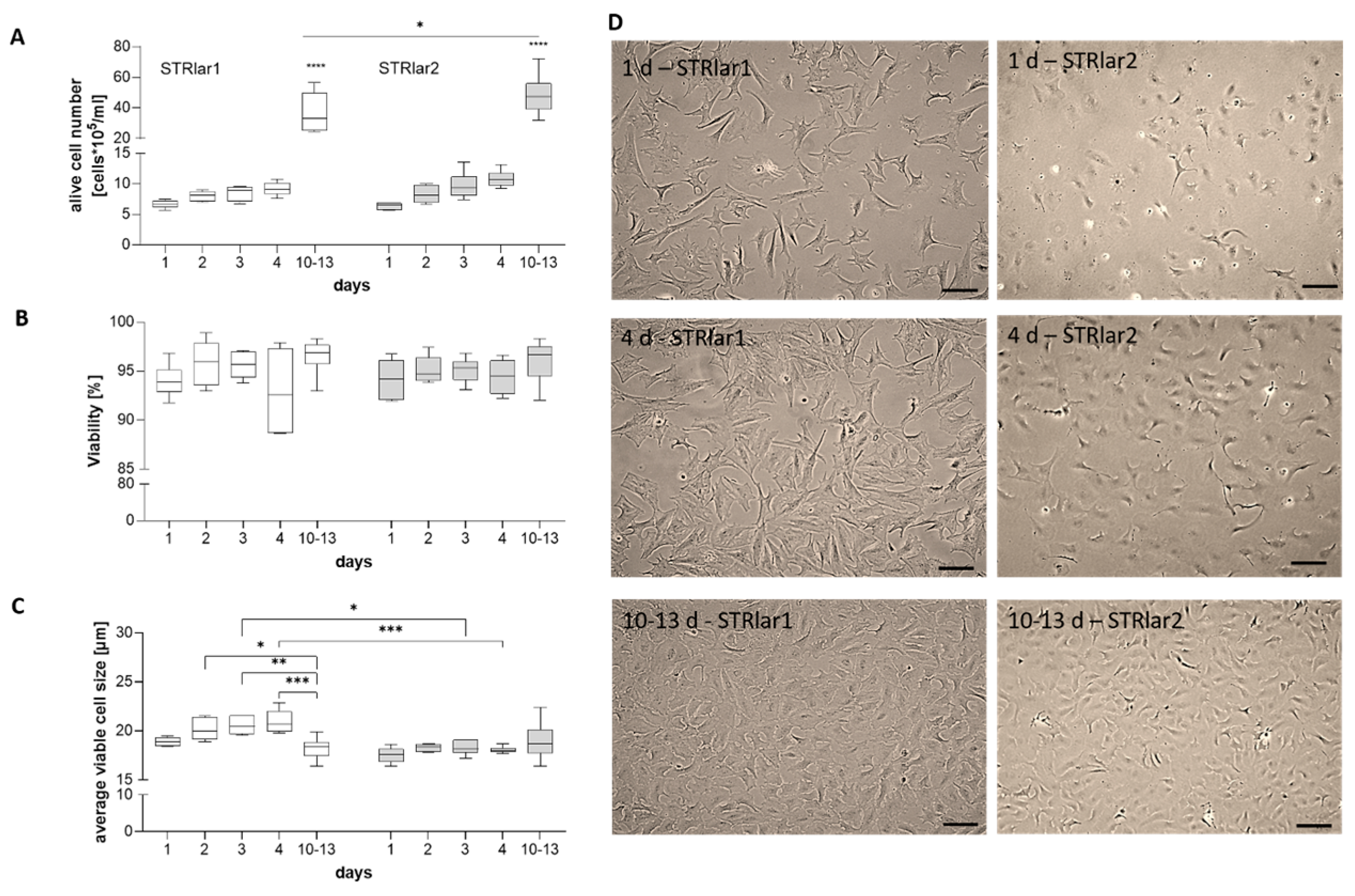

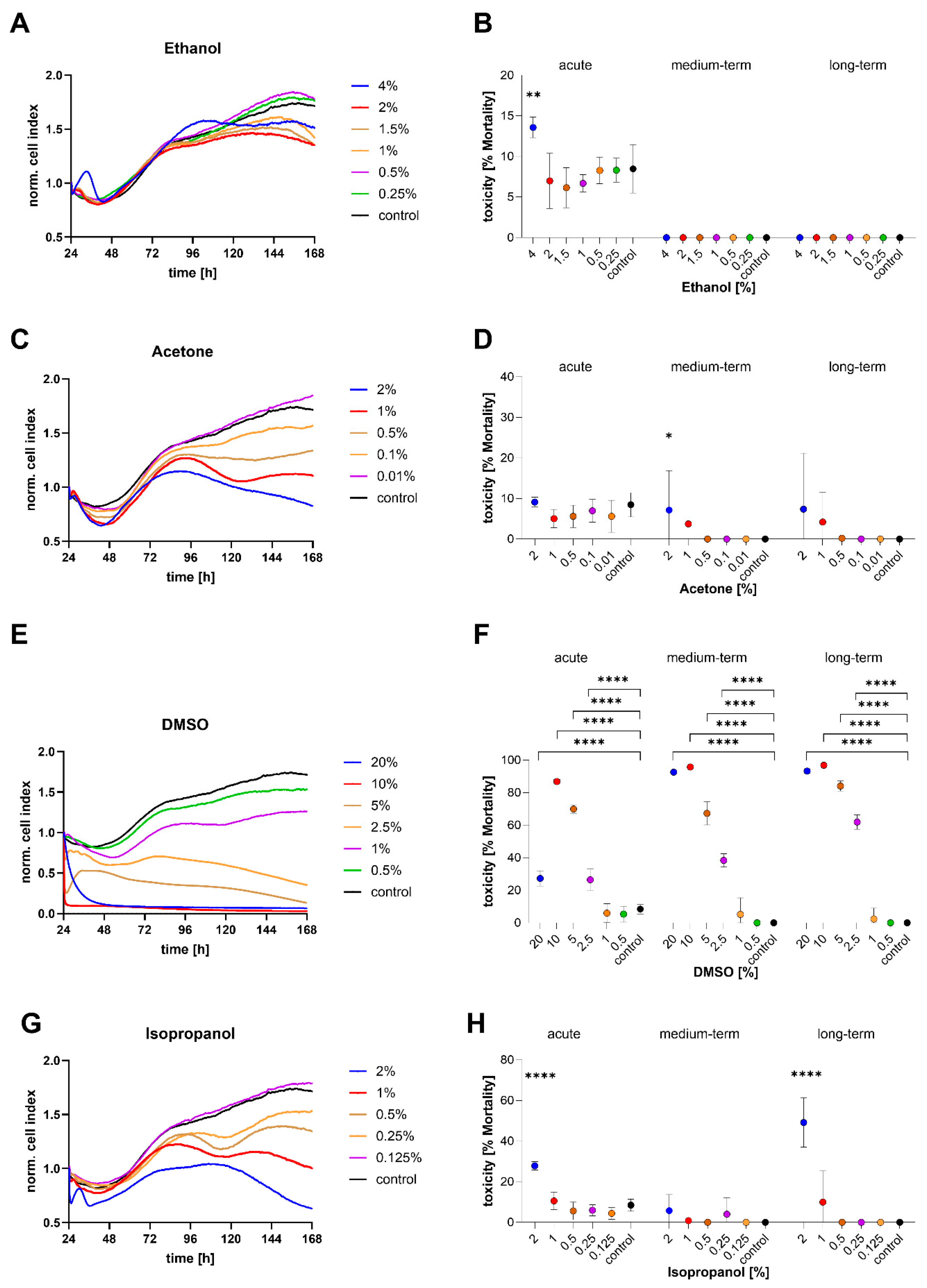

Disclaimer/Publisher’s Note: The statements, opinions and data contained in all publications are solely those of the individual author(s) and contributor(s) and not of MDPI and/or the editor(s). MDPI and/or the editor(s) disclaim responsibility for any injury to people or property resulting from any ideas, methods, instructions or products referred to in the content. |
© 2025 by the authors. Licensee MDPI, Basel, Switzerland. This article is an open access article distributed under the terms and conditions of the Creative Commons Attribution (CC BY) license (https://creativecommons.org/licenses/by/4.0/).
Share and Cite
Grunow, B.; Di Leonardo, V.; Tönißen, K. Towards Animal-Free Toxicology: Establishment of Two Larval Brown Trout Cell Lines for Environmental Risk Assessment. Toxics 2025, 13, 696. https://doi.org/10.3390/toxics13080696
Grunow B, Di Leonardo V, Tönißen K. Towards Animal-Free Toxicology: Establishment of Two Larval Brown Trout Cell Lines for Environmental Risk Assessment. Toxics. 2025; 13(8):696. https://doi.org/10.3390/toxics13080696
Chicago/Turabian StyleGrunow, Bianka, Valeria Di Leonardo, and Katrin Tönißen. 2025. "Towards Animal-Free Toxicology: Establishment of Two Larval Brown Trout Cell Lines for Environmental Risk Assessment" Toxics 13, no. 8: 696. https://doi.org/10.3390/toxics13080696
APA StyleGrunow, B., Di Leonardo, V., & Tönißen, K. (2025). Towards Animal-Free Toxicology: Establishment of Two Larval Brown Trout Cell Lines for Environmental Risk Assessment. Toxics, 13(8), 696. https://doi.org/10.3390/toxics13080696




